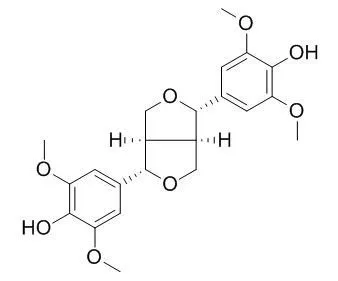| In vitro: |
| Oncotarget. 2015 Jan 1;6(1):43-55. | | Syringaresinol protects against hypoxia/reoxygenation-induced cardiomyocytes injury and death by destabilization of HIF-1α in a FOXO3-dependent mechanism.[Pubmed: 25415049] | Hypoxia-inducible factor 1 (HIF-1) is a master regulator of hypoxic response and has been a prime therapeutic target for ischemia/reperfusion (I/R)-derived myocardial dysfunction and tissue damage. There is also increasing evidence that HIF-1 plays a central role in regulating aging, both through interactions with key longevity factors including Sirtuins and mTOR, as well as by directly promoting longevity in Caenorhabditis elegans.
METHODS AND RESULTS:
We investigated a novel function and the underlying mechanism of Syringaresinol, a lignan compound, in modulation of HIF-1 and protection against cellular damage and death in a cardiomyocyte model of I/R injury. Syringaresinol caused destabilization of HIF-1α following H/R and then protected against hypoxia/reoxygenation (H/R)-induced cellular damage, apoptosis, and mitochondrial dysfunction in a dose-dependent manner. Knock-down of FOXO3 by specific siRNAs completely abolished the ability of Syringaresinol to inhibit HIF-1 stabilization and apoptosis caused by H/R. Syringaresinol stimulated the nuclear localization and activity of FOXO3 leading to increased expression of antioxidant genes and decreased levels of reactive oxygen species (ROS) following H/R.
CONCLUSIONS:
Our results provide a new mechanistic insight into a functional role of Syringaresinol against H/R-induced cardiomyocyte injury and death. The degradation of HIF-1α through activation of FOXO3 is a potential therapeutic strategy for ischemia-related diseases. | | Int Immunopharmacol. 2008 Jul;8(7):967-73. | | (-)-Syringaresinol inhibits proliferation of human promyelocytic HL-60 leukemia cells via G1 arrest and apoptosis.[Pubmed: 18486907] |
METHODS AND RESULTS:
We examined the effect of (-)-Syringaresinol, a furofuran-type lignan isolated from Daphne genkwa, on cell cycle regulation in HL-60 human promyelocytic leukemia cells in vitro. (-)-Syringaresinol decreased the viability of HL-60 cells by inducing G(1) arrest followed by apoptosis in a dose- and time-dependent manner. The G(0)/G(1) phase of the cell cycle is regulated by cyclin-dependent kinases (Cdk), cyclins and cyclin-dependent kinase inhibitors (Cdki). We show by western blot analysis, that the (-)-Syringaresinol-induced G(1) arrest was mediated through the increased expression of Cdki proteins (p21(cip1/waf1) and p27(kip1)) with a simultaneous decrease in cdk2, cdk4, cdk6, cyclin D(1), cyclin D(2), and cyclin E expression. The induction of apoptosis after treatment with (-)-Syringaresinol for 24 h was demonstrated by morphological changes, DNA fragmentation, altered ratio of Bax/Bcl-2, cleavage of poly(ADP-ribose) polymerase and flow cytometry analysis. (-)-Syringaresinol also induced cytochrome c release and activation of caspase-3 and caspase-9. To our knowledge, this is the first time that (-)-Syringaresinol has been reported to potently inhibit the proliferation of human promyelocytic HL-60 cells through G(1) arrest and induction of apoptosis.
CONCLUSIONS:
These findings suggest that (-)-Syringaresinol may be a potential chemotherapeutic agent for the treatment of cancer. |
|






 Cell. 2018 Jan 11;172(1-2):249-261.e12. doi: 10.1016/j.cell.2017.12.019.IF=36.216(2019)
Cell. 2018 Jan 11;172(1-2):249-261.e12. doi: 10.1016/j.cell.2017.12.019.IF=36.216(2019) Cell Metab. 2020 Mar 3;31(3):534-548.e5. doi: 10.1016/j.cmet.2020.01.002.IF=22.415(2019)
Cell Metab. 2020 Mar 3;31(3):534-548.e5. doi: 10.1016/j.cmet.2020.01.002.IF=22.415(2019) Mol Cell. 2017 Nov 16;68(4):673-685.e6. doi: 10.1016/j.molcel.2017.10.022.IF=14.548(2019)
Mol Cell. 2017 Nov 16;68(4):673-685.e6. doi: 10.1016/j.molcel.2017.10.022.IF=14.548(2019)